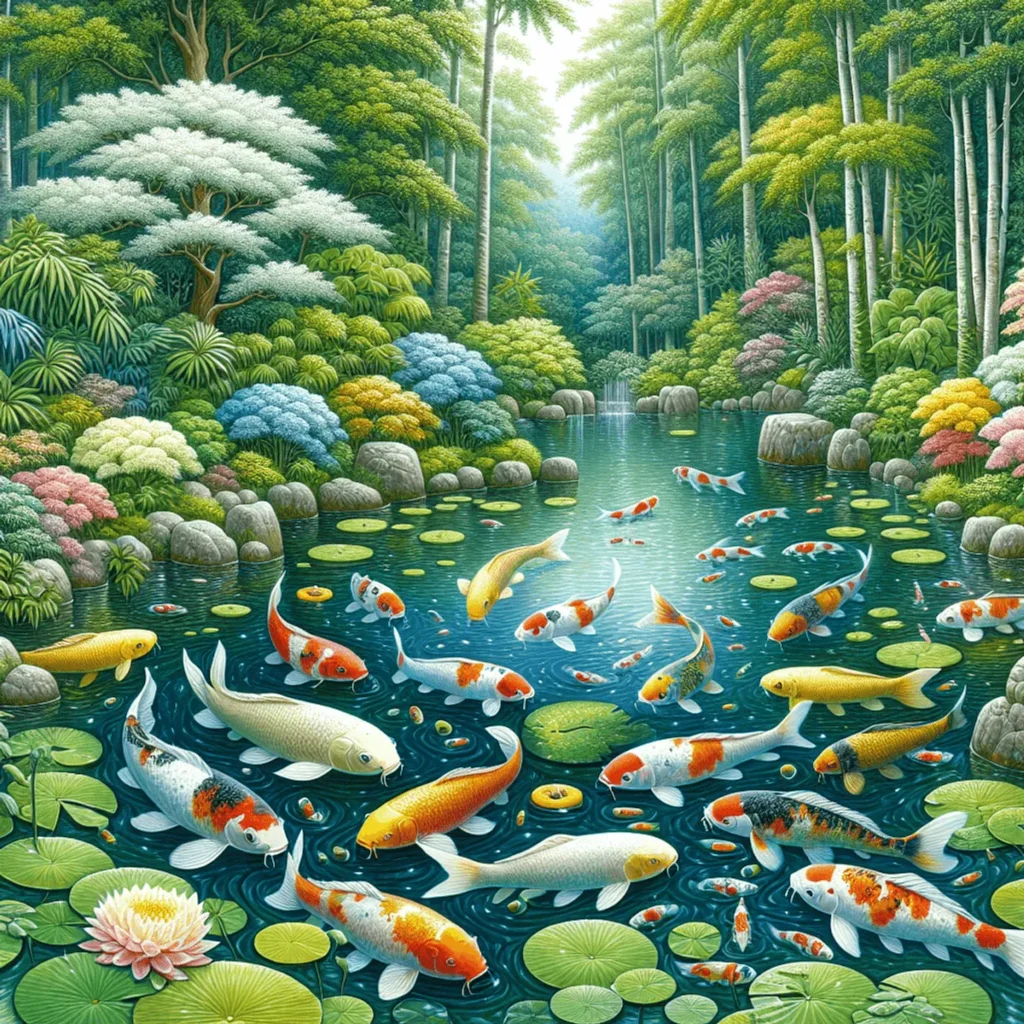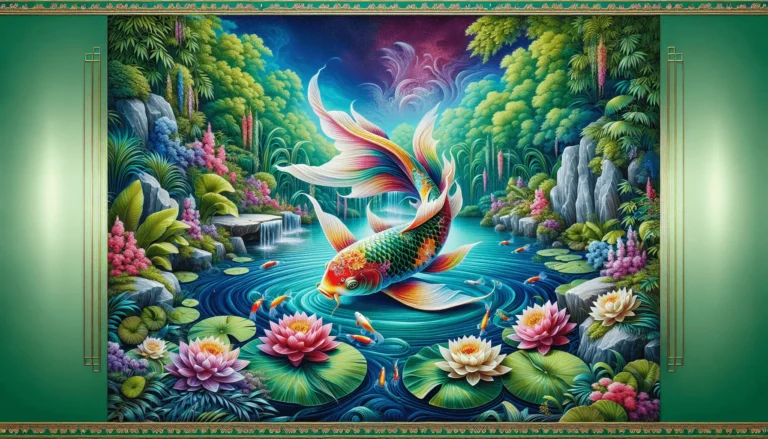The Truth About Koi Fish Aggression
Koi fish are known for their beautiful colors and calm nature. But the question is: are koi fish aggressive? Usually, koi are peaceful pond dwellers, appreciated for their relaxed and social behavior. However, in certain situations, koi fish aggression can show up.
Understanding how koi behave is essential for keeping a peaceful pond environment. Key takeaway: By learning what causes koi aggression, you can create harmony among your aquatic pets.
Characteristics of Koi Fish:
- Appearance: Brightly colored with intricate patterns
- Behavior: Generally social and non-aggressive
- Lifespan: Can live up to 25-35 years in optimal conditions
Reputation for Aggression:
While koi are usually gentle, specific scenarios might provoke aggressive behaviors. Common triggers include:
- Environmental stressors such as poor water quality or overcrowding
- Competition during feeding times
- Hormonal changes during the breeding season
Recognizing these factors aids in preventing and managing aggression, ensuring a balanced ecosystem in your pond.
1. Understanding Koi Fish Behavior
General Temperament of Koi Fish
Koi fish are often regarded as mellow fish due to their generally peaceful nature. Unlike other species such as bettas, koi are not inherently aggressive. They tend to coexist harmoniously with other fish, making them a popular choice for diverse pond ecosystems.
Differences Between Aggressive and Peaceful Behaviors in Koi
While koi are typically non-aggressive, their behavior can change under certain conditions. You can read more about koi fish aggressive behavior here.
- Peaceful Behaviors: Swimming calmly, interacting gently with other fish, and feeding without competition.
- Aggressive Behaviors: Chasing, nipping at other fish, and rapid swimming patterns.
It’s crucial to distinguish between these behaviors to manage your pond effectively.
Recognizing Signs of Stress in Koi
Stress can lead to aggressive reactions in koi. Key indicators of stress include:
- Reduced Activity Levels: Lethargic movements or spending prolonged periods at the bottom of the pond.
- Erratic Swimming Patterns: Sudden bursts of speed or irregular movements.
- Visible Physical Changes: Discoloration or clamped fins.
Understanding these signs can help you address underlying issues before they escalate into aggressive behavior.
2. Causes of Aggression in Koi Fish
Natural Disposition and Genetics
Koi fish’s natural disposition and genetics can play a significant role in their aggression levels. Some koi may inherently possess more aggressive tendencies due to their genetic makeup. These variations are typically subtle but can become pronounced under certain conditions.
Environmental Stressors
Environmental stressors are critical triggers for aggressive behaviors in koi fish:
- Poor water quality, such as imbalanced pH levels or high ammonia content, can cause significant stress.
- Overcrowding is another major factor; a crowded pond can lead to competition for space, escalating tensions among the fish.
Read Also: Ultimate Guide to Raising Koi Fish: Care, Feeding & Health
Insufficient Food
The availability of food is crucial for maintaining a peaceful koi pond. Insufficient food can lead to aggressive behavior during feeding times. Koi may exhibit competitive and aggressive behaviors as they scramble for the limited food sources. Ensuring that all fish are adequately fed helps mitigate this type of aggression.
Understanding these causes of aggression can aid in creating a more harmonious environment for your koi fish, reducing stressors and promoting overall well-being.
3. The Role of Breeding Season in Koi Aggression
During the breeding season, the behavior of koi fish can change dramatically. Hormonal changes lead to heightened aggression in male koi. These hormonal fluctuations drive males to exhibit more assertive behaviors as they compete for the attention of females.
Hormonal Changes
Male koi become more territorial and aggressive due to increased testosterone levels. This is a natural part of their breeding behavior. It’s important to note that this aggression often manifests through chasing and biting, which are essential components of their mating rituals. Chasing is a way for males to encourage females to release eggs, while biting helps stimulate this process.
Mating Rituals
The chasing and biting seen during these times are not purely aggressive but rather integral parts of their reproductive activities. Understanding these behaviors can help you differentiate between typical breeding behaviors and genuine aggression. By recognizing that these actions are driven by natural instincts, you can take steps to provide an environment that accommodates these needs without misinterpreting their actions as signs of persistent aggression.
However, it’s also crucial to understand that the increased aggression during the breeding season can sometimes lead to injuries among koi if not managed properly. Implementing strategies such as providing ample space, creating hiding spots, and maintaining optimal water conditions can significantly reduce the risk of injury during this period. For more insights into how to manage koi behavior during breeding season, you may want to explore this comprehensive guide.
4. Interactions Between Koi and Other Fish Species
Looking at how well koi get along with goldfish and other pond mates shows both potential benefits and drawbacks. Koi fish are usually peaceful, but their larger size and energetic nature can sometimes create challenges when living with smaller or more passive species.
Compatibility Factors:
- Size Difference: Koi can grow much larger than goldfish, which might lead to unintentional bullying or dominance.
- Behavioral Differences: While koi are generally peaceful, their energetic swimming patterns can stress smaller fish who prefer calmer environments.
How competitive feeding behaviors among different species can result in aggressive encounters. Feeding time is a critical period when aggression may surface due to competition for food.
Feeding Dynamics:
- Koi Feeding Habits: Koi tend to be vigorous feeders, often outcompeting slower or smaller fish for food.
- Impact on Goldfish: Goldfish, being less aggressive feeders, might struggle to get adequate nutrition if housed with more dominant koi.
Ensuring a balanced diet and enough feeding areas can help reduce these issues. Creating separate feeding zones or using floating feeding rings can reduce competition and promote harmony in the pond.
5. Misinterpreting Koi Feeding Behavior as Aggression

Koi fish have unique feeding habits that can sometimes be mistaken for aggressive behavior. Unlike some other species, koi tend to nibble rather than bite aggressively. This nibbling is part of their natural feeding style and is not an indication of hostility.
Koi Food Preferences and Feeding Time Dynamics
Nibbling vs. Biting
Koi often nibble at food sources instead of taking large bites. This behavior can be misinterpreted as aggression, especially during feeding time when multiple koi are competing for the same food.
Teeth Structure
Koi possess teeth similar to human molars located at the back of their throats. These teeth are adapted for grinding various kinds of food, such as shells and insects, rather than tearing flesh. This adaptation further supports their non-aggressive feeding style.
Read Also: How to Sell Koi Fish: Pricing, Quality, and Market Tips
Feeding Time Dynamics
During feeding times, the competition for food can become intense, leading to what might appear as aggressive encounters. However, this is typically a result of their eagerness to eat rather than genuine aggression towards one another.
It’s worth noting that while koi have unique feeding habits, other fish species like cichlids have different behaviors and preferences when it comes to feeding. Understanding these aspects of koi feeding behavior helps clarify that what might seem like aggression is often just their natural way of eating. Recognizing this can aid in creating a more harmonious pond environment by ensuring that all fish have adequate access to food and reducing unnecessary stress during feeding times.
6. Environmental Factors That Influence Koi Behavior
Keeping your koi pond in good condition is essential for reducing stress and ensuring the well-being of your koi fish. One important aspect is proper pond maintenance, which includes regular cleaning, water changes, and having a good filtration system. Stagnant or dirty water can lead to health problems and stress, potentially making koi fish more aggressive.
Key Water Quality Parameters
Water quality plays a major role in both the physical health and behavior of koi. Here are some key factors to consider:
- pH Levels: Koi do best in slightly alkaline water with pH levels between 7.0 and 8.6. Changes outside this range can cause stress and lead to unusual behavior.
- Ammonia and Nitrite: High levels of ammonia and nitrite are harmful to koi and can make them more aggressive due to discomfort or illness.
- Temperature: Koi are cold-water fish but prefer stable temperatures ranging from 59°F to 77°F (15°C to 25°C). Sudden changes can be stressful.
- Salt Levels: Interestingly, keeping a certain level of salt in the pond can have benefits for koi health. However, it’s important to understand whether keeping salt in the koi pond permanently is a good practice or not.
Creating a Stress-Free Habitat
Regularly checking these water parameters will help you maintain an optimal environment for your koi. Additionally, providing enough shelter and hiding spots can also reduce stress, allowing your koi to display their natural, calm behavior instead of aggression.
By understanding these environmental factors, you can create a peaceful pond environment where your koi fish can thrive without unnecessary stress or aggressive behavior.
7. Managing Aggressive Behaviors in Koi Fish
To manage aggressive behaviors in koi fish, consider the following strategies:
- Separate Aggressive Individuals: If certain koi are consistently aggressive, isolating them temporarily can reduce tension.
- Provide Adequate Space: Overcrowding can exacerbate aggression. Ensure your pond is spacious enough for all inhabitants.
- Improve Water Quality: Regularly test and maintain water parameters to minimize stress-induced aggression.
- Enhance Shelter Options: Incorporate hiding spots and plants to give koi a sense of security and territory.
- Monitor Feeding Practices: Distribute food evenly across the pond to prevent competition that may lead to aggression.
Understanding these methods will help you create a more harmonious environment for your koi fish. Proper management of their living conditions can significantly reduce the likelihood of aggressive behaviors.
FAQs (Frequently Asked Questions)
Are koi fish aggressive?
Koi fish are generally known for their peaceful nature. However, understanding the truth behind koi aggression is essential for creating a harmonious pond environment.
What causes aggression in koi fish?
Aggression in koi can stem from several factors, including natural disposition and genetics, environmental stressors like poor water quality or overcrowding, and insufficient food availability.
How does the breeding season affect koi aggression?
During the breeding season, hormonal changes can heighten aggression in male koi. Chasing and biting behaviors during mating rituals may be misinterpreted as aggression.
Can koi fish be aggressive towards other species?
Koi can exhibit aggressive behaviors towards other fish species, such as goldfish, particularly during competitive feeding situations. Compatibility with pond mates should be carefully considered.
Is feeding behavior in koi fish a sign of aggression?
Koi have unique feeding habits that involve nibbling rather than biting aggressively. Their physical adaptations, such as tooth structure, contribute to this feeding style rather than indicating aggression.
What environmental factors influence koi behavior?
Maintaining a healthy pond environment is crucial for reducing stress levels in koi. Factors like water quality parameters (e.g., pH levels) significantly impact both the physical health and behavioral patterns of koi.




